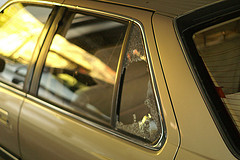According to the FBI, a motor vehicle is stolen every 25 seconds in the USA, and fewer than 50 percent of those stolen cars are ever recovered. Where do they all go? Is there a big closet filled with stolen cars somewhere? Or do they go to that secret part of the clothes dryer that also hides individual socks? No, many of them end up back on the street, but under an assumed Vehicle Identification Number (VIN).

flic.kr/p/4dtLZG
How do you protect yourself from buying one of these stolen vehicles? It isn’t easy, because a car thieves will pass off a stolen car as legitimate by replacing its VIN, which is on law enforcement “hot sheets,” with another VIN, often from a junked vehicle.
“Car thieves go into car lots to find vehicles that match the cars they steal,” said Larry Gamache of Carfax. “They’ll take off the VIN plate and put it on one they just stole. Then they’ll sell it to someone who has no idea it’s a stolen vehicle.”
Gamache says protecting yourself from VIN cloning starts by checking the VIN number on the dashboard against the car’s title documents. If there’s a discrepancy that’s a sure sign something is amiss. But there are other steps you should take as well.
“You should also match that number in other places, including under the hood and at the door jamb on the driver’s side,” Gamache said. “Then check that vehicle ID number to make sure it matches in all three spots.”
Another way to protect yourself is to get a comprehensive vehicle history report from Carfax.com. If you think you’re a victim of VIN cloning, contact your local police department.
Tagged with: car records • VIN cloning
Filed under: Buy A Car